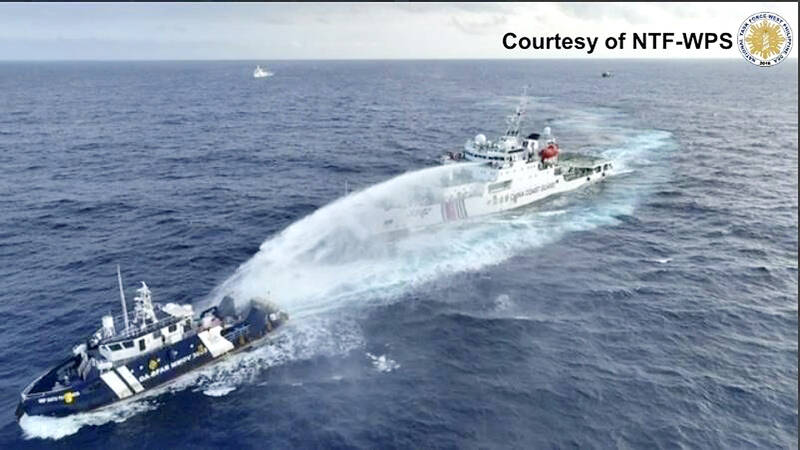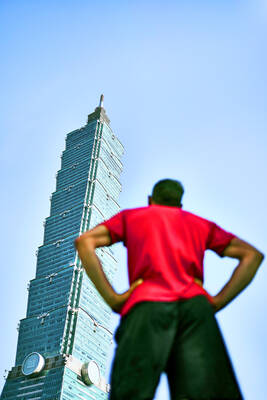China’s live-fire drills in April and earlier this month serve a dual purpose: challenging the US-led coalition politically and enhancing its ability to project sea power to further its ambitions, a Taiwanese defense expert said.
In an analysis for the Institute for National Defense and Security Research, a Taipei-based government-affiliated think tank, analyst Tsiam Siong-ui (詹祥威) said that China’s drills were closely timed in response to joint exercises conducted by the US, Japan and the Philippines.
Citing an example, he said that China’s live-fire drills in April followed an outbreak of confrontations between the Chinese and Philippine coast guards near the disputed Scarborough Shoal (Huangyan Island, 黃岩島), which included ship collisions that resulted in hull damage and injuries.

Photo: EPA-EFE
Evidence from the clashes reinforces the view that Beijing has been a persistent aggressor, he added.
The China Coast Guard conducted an average of 95 ship-days of patrols from January to last month, almost double the monthly average of 48 ship-days recorded from August to December last year, Tsiam said.
This increased patrol frequency was directly responsible for the surge in hostile interactions at sea with the Philippine Coast Guard, with nearly 12 incidents occurring per month, he said.
China’s live-fire exercise in April appeared to be a direct response to the US-Philippine joint exercise, the Maritime Cooperative Activity, Tsiam said.
The more recent drill, held from June 18 to June 20, was scheduled almost immediately following training and patrol operations by the US aircraft carrier USS Nimitz and destroyer USS Curtis Wilbur in the South China Sea, he said.
Additionally, Japan and the Philippines’ own joint maritime security drill occurred just one day before China’s announcement of its latest live-fire exercise, Tsiam said.
These actions suggest Beijing’s intent to intensify the frequency and scale of its drills, reinforcing its aim to establish control as a fait accompli, Tsiam explained.
However, the drills also serve practical military purposes. The Chinese People’s Liberation Army (PLA) needs to turn China’s near waters into a secure base of operations should it engage in a Taiwan invasion or a conflict further afield, he said.
Current Chinese military doctrine emphasizes using three tiers of naval forces — the Chinese Maritime Militia, the coast guard and the PLA Navy (PLAN) — to engage in low, medium and high-intensity conflicts, Tsiam said.
The PLA Southern Military Command’s main tool to ensure the three naval arms operate together efficiently is the live-fire exercise, he said, adding that the exercise area, situated 12 nautical miles (22.2km) from Hainan, aligns with PLAN operational requirements.
China’s unprecedented simultaneous deployment this month of two carrier strike groups, centered around the Liaoning and the Shandong, was no accident, but instead a deliberate display of strength, he said.
The concurrent deployment of the two carriers was intended to signal that PLAN has operationalized new technologies ahead of schedule and attained naval capabilities that are a strategic match to those of the US and Japan, he said.
Taken together, China’s exercises enabled Beijing to project strength to an international and domestic audience, demonstrate its ability to respond quickly to unforeseen situations and enhance its military capabilities, he added.
While Beijing is currently focused on maintaining regional equilibrium, its swift response to actions by the US, Japan and the Philippines suggests it possesses a significant capability to exploit international conditions, he said.

US climber Alex Honnold is to attempt to scale Taipei 101 without a rope and harness in a live Netflix special on Jan. 24, the streaming platform announced on Wednesday. Accounting for the time difference, the two-hour broadcast of Honnold’s climb, called Skyscraper Live, is to air on Jan. 23 in the US, Netflix said in a statement. Honnold, 40, was the first person ever to free solo climb the 900m El Capitan rock formation in Yosemite National Park — a feat that was recorded and later made into the 2018 documentary film Free Solo. Netflix previewed Skyscraper Live in October, after videos

NUMBERS IMBALANCE: More than 4 million Taiwanese have visited China this year, while only about half a million Chinese have visited here Beijing has yet to respond to Taiwan’s requests for negotiation over matters related to the recovery of cross-strait tourism, the Tourism Administration said yesterday. Taiwan’s tourism authority issued the statement after Chinese-language daily the China Times reported yesterday that the government’s policy of banning group tours to China does not stop Taiwanese from visiting the country. As of October, more than 4.2 million had traveled to China this year, exceeding last year. Beijing estimated the number of Taiwanese tourists in China could reach 4.5 million this year. By contrast, only 500,000 Chinese tourists are expected in Taiwan, the report said. The report

Temperatures are forecast to drop steadily as a continental cold air mass moves across Taiwan, with some areas also likely to see heavy rainfall, the Central Weather Administration (CWA) said. From today through early tomorrow, a cold air mass would keep temperatures low across central and northern Taiwan, and the eastern half of Taiwan proper, with isolated brief showers forecast along Keelung’s north coast, Taipei and New Taipei City’s mountainous areas and eastern Taiwan, it said. Lows of 11°C to 15°C are forecast in central and northern Taiwan, Yilan County, and the outlying Kinmen and Lienchiang (Matsu) counties, and 14°C to 17°C

STEERING FAILURE: The first boat of its class is experiencing teething issues as it readies for acceptance by the navy, according to a recent story about rudder failure The Hai Kun (海鯤), the nation’s first locally built submarine, allegedly suffered a total failure of stern hydraulic systems during the second round of sea acceptance trials on June 26, and sailors were forced to manually operate the X-rudder to turn the submarine and return to port, news Web site Mirror Daily reported yesterday. The report said that tugboats following the Hai Kun assisted the submarine in avoiding collisions with other ships due to the X-rudder malfunctioning. At the time of the report, the submarine had completed its trials and was scheduled to begin diving and surfacing tests in shallow areas. The X-rudder,